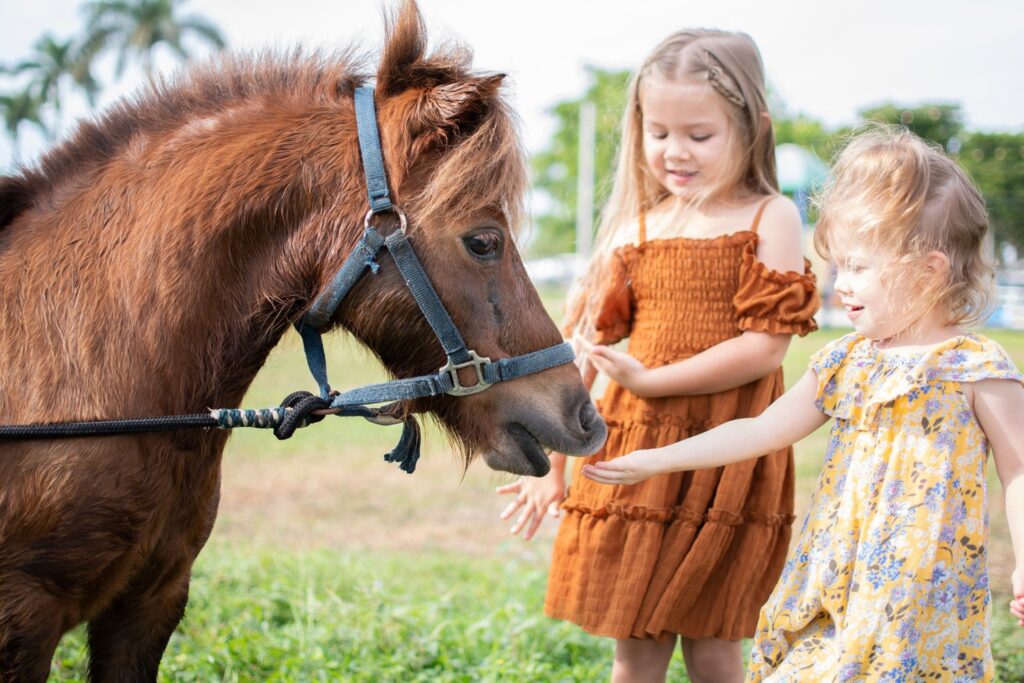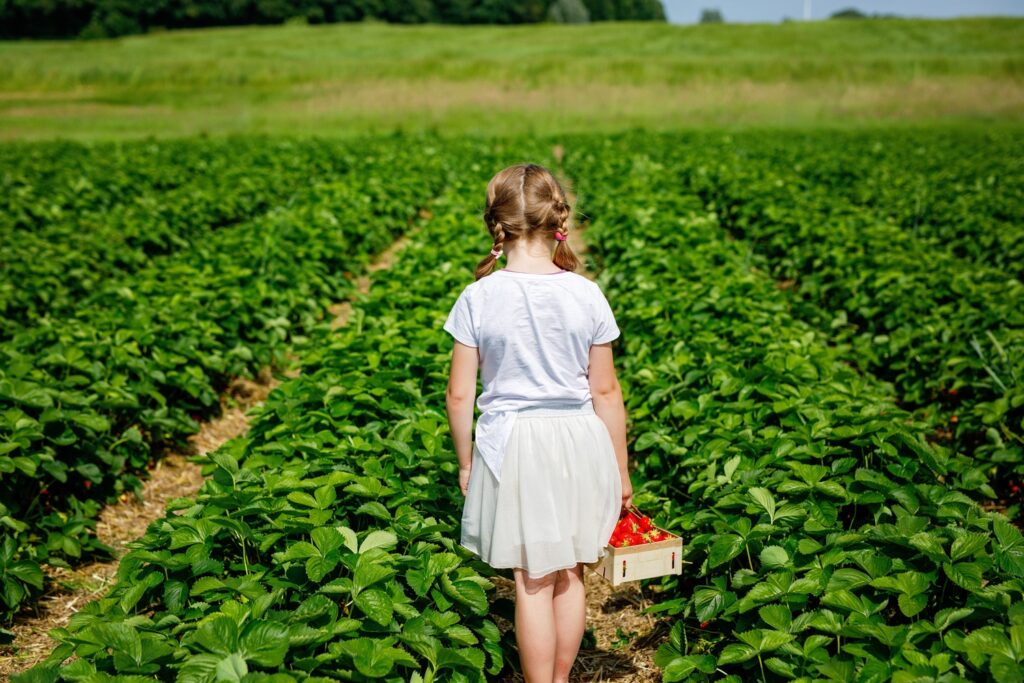
Farm adventures are becoming a popular choice for families seeking fun and educational experiences. There’s something truly special about spending time outdoors, surrounded by nature, and learning about where our food comes from. But how can you ensure that everyone in the family, from toddlers to teens, enjoys their farm visit? This guide will show you how to make farm adventures enjoyable for kids of all ages.
Safety First
A farm is a wonderful place for kids to explore and learn, but it’s essential to prioritize safety. Let’s break down some safety measures based on different age groups.
Safety for Toddlers and Preschoolers
- Constant Supervision: Little ones require constant attention. Never let them out of your sight, especially near animals or equipment.
- Safe Play Areas: Designate specific play areas away from farm operations. Use baby gates or fences to create safe boundaries.
- Animal Interactions: Supervise all animal interactions. Teach children to be gentle and respectful of animals, and avoid approaching unfamiliar animals.
Safety for School-Aged Children
- Age-Appropriate Activities: Choose activities that match their age and abilities. For example, older kids can help feed animals under supervision, while younger ones might enjoy petting smaller animals.
- Equipment Safety: If using farm equipment, ensure it’s age-appropriate and in good condition. Always wear protective gear like helmets and gloves when necessary.
- Water Safety: If there are ponds or streams, teach children about water safety and the importance of adult supervision.
Safety for Teenagers
- Responsible Behavior: Emphasize responsible behavior around animals and equipment. Teach them about the potential dangers and the importance of following safety guidelines.
- First Aid Training: Consider basic first aid training for older teens to prepare them for unexpected situations.
- Emergency Procedures: Discuss emergency procedures, such as where to find a first aid kit or how to contact help in case of an accident.
Creating a Safe Environment for All
- Clear Pathways: Keep walkways clear of obstacles to prevent falls and accidents.
- Emergency Exits: Following best practices, Mazeplay and other maze design companies emphasize clear pathways and emergency exits in their designs. This principle can be applied to other farm structures as well.
- Regular Inspections: Regularly inspect the farm for potential hazards, such as broken fences or exposed wires.
- Animal Care: Ensure animals are well-cared for and not aggressive. This reduces the risk of animal-related incidents.
- First Aid Kit: Have a well-stocked first aid kit readily available.
Implementing these safety measures will create a fun and secure environment for children of all ages to enjoy their farm adventures.
Interactive Farm Tours
Interactive farm tours are a fantastic way to make visits exciting and educational for kids of all ages. By offering hands-on experiences, you can spark curiosity and create lasting memories.
Guided Tours with Hands-On Experiences
A guided tour provides structure and information, while hands-on activities keep kids engaged. Here are some ideas:
- Animal Encounters: Let kids feed or brush animals like horses, goats, or sheep.
- Gardening Activities: Plant seeds, harvest vegetables, or learn about composting.
- Farm Equipment Demonstrations: Show kids how farm equipment works, but from a safe distance.
- Sensory Experiences: Encourage kids to touch different textures like wool, feathers, or soil.
Educating Children About Farm Life and Animals
While exploring the farm, incorporate educational elements:
- Animal Facts: Share interesting facts about the animals kids meet, such as their diet, habitat, and behavior.
- Farm Processes: Explain how crops grow, how milk is produced, or how eggs are collected.
- Sustainability: Discuss the importance of caring for the environment and sustainable farming practices.
Combining guided tours with interactive activities creates farm adventures that are both fun and informative for everyone.
Corn Mazes and Hayrides
Corn mazes and hayrides are classic farm activities that can be enjoyed by people of all ages. Here’s how to make them fun and safe for everyone.
Designing Corn Mazes Suitable for Different Age Groups
Corn mazes can be a thrilling adventure for kids and adults alike. To accommodate different age groups, consider creating multiple mazes with varying levels of difficulty:
- Toddler Maze: Design a small, simple maze with wide paths and clear sightlines. Include fun elements like oversized farm animal cutouts or colorful flags.
- Kid-Friendly Maze: Create a slightly larger maze with more twists and turns. Incorporate interactive elements like puzzles or scavenger hunts.
- Challenge Maze: Design a complex maze with longer paths and more dead ends for older kids and adults. You can add difficulty by including tricky turns or elevation changes.
Organizing Fun and Safe Hayrides
Hayrides are a great way to see the farm and enjoy the outdoors. To ensure a safe and enjoyable experience for everyone:
- Wagon Safety: Inspect the hayride wagon regularly for any safety hazards, such as loose boards or worn-out tires.
- Passenger Safety: Provide clear instructions for passengers, such as staying seated and holding on.
- Route Planning: Choose a safe route for the hayride, avoiding obstacles and uneven terrain.
- Weather Considerations: Cancel hayrides if the weather is inclement, such as heavy rain or thunderstorms.
- Themed Hayrides: Enhance the experience by offering themed hayrides, like a pumpkin patch hayride or a spooky Halloween hayride.
Carefully planning and executing these activities can create unforgettable farm memories for families of all ages.
Building Play Areas with Farm-Themed Equipment
Transform your playground into a farm-themed wonderland with creative equipment choices:
- Animal-Shaped Structures: Install play equipment shaped like farm animals, such as a cow slide, a horse spring rider, or a pig seesaw.
- Farm-Inspired Playsets: Opt for playsets that resemble barns, tractors, or hay bales.
- Sensory Play Areas: Create a sensory-rich area with elements like sandboxes, water play features, and touch-and-feel stations.
Incorporating Educational Play Elements
Combine fun with learning by adding educational elements to your playground:
- Interactive Signs: Place informative signs around the playground with facts about farm animals, plants, or equipment.
- Role-Playing Stations: Set up areas for kids to pretend they’re farmers, veterinarians, or grocery store owners.
- Nature Exploration: Encourage kids to explore the natural world by providing magnifying glasses, binoculars, or nature journals.
By designing a well-thought-out farm-themed playground, you can create a space where kids can play, learn, and have a blast.
Educational Workshops and Classes
Enrich your farm experience by offering educational workshops and classes. These interactive sessions can deepen kids’ understanding of farm life and inspire a love for nature.
For the youngest visitors, consider hands-on activities like planting seeds, feeding baby animals, or learning about the lifecycle of a butterfly. Older children might enjoy more in-depth workshops on topics such as animal care, sustainable farming, or the science behind soil health.
Tailoring classes to different age groups is key. Younger kids thrive on short, engaging activities with plenty of sensory experiences. Older children benefit from more complex topics and opportunities for hands-on exploration.
Offering a variety of workshops and classes caters to diverse interests and learning styles. This ensures that every child leaves with a deeper appreciation for the farm and its inhabitants.
Farm-to-Table Experiences
Connecting kids to their food source is a valuable lesson. Farm-to-table experiences can be a fun and educational way to show children where their food comes from and why it’s important to eat healthily.
Teaching children about food production is as simple as taking them on a tour of the farm. Let them see the crops growing, the animals providing dairy products, and the process of harvesting. Explaining how food goes from the field to their plate can spark curiosity and encourage healthy eating habits.
Organizing farm-to-table meals is a delicious way to reinforce this concept. Serve dishes made with fresh, locally sourced ingredients. For a hands-on experience, consider hosting cooking classes where kids can learn to prepare simple recipes using ingredients from the farm. This is a great opportunity to teach about nutrition and the importance of balanced meals.
Craft and Art Stations
Stimulate kids’ creativity with dedicated craft and art stations. These areas offer a wonderful opportunity for children to express themselves while learning about farm life.
Set up a space with tables, chairs, and a variety of supplies. Provide materials like construction paper, markers, crayons, and glue. Offer farm-themed craft ideas such as creating animal masks, building miniature barns, or decorating planters. Natural materials like dried flowers, feathers, and corn husks can also be incorporated into the craft station.
Encourage free expression through art projects. Set up an easel with paints and brushes, or provide large sheets of paper for drawing and coloring. Offer farm-inspired themes like painting animals, landscapes, or farm equipment. Nature-based art projects, such as creating leaf rubbings or pressing flowers, can also be incorporated.
By providing a space for creativity and imagination, you’ll foster a love for art and nature in children of all ages.
A Farm Adventure for Everyone
Creating enjoyable farm adventures for kids of all ages requires careful planning and a variety of engaging activities. By understanding the needs of different age groups and prioritizing safety, farms can offer experiences that are both fun and educational.
Incorporating interactive elements and family-friendly amenities ensures that every visit is memorable. Thoughtful execution of these elements can transform farms into popular destinations where families create lasting memories together, fostering a deeper appreciation for farm life.












Leave a Reply